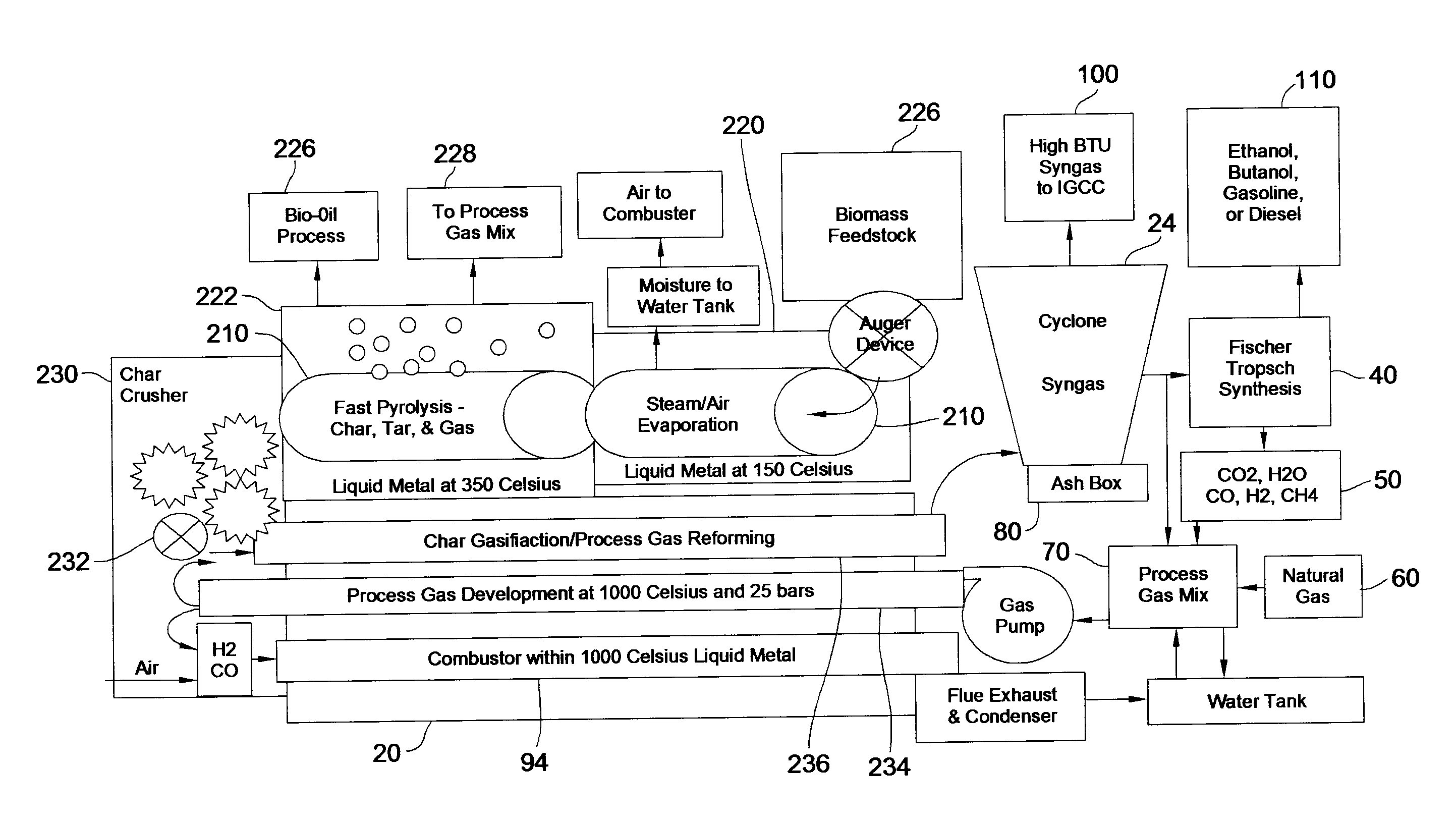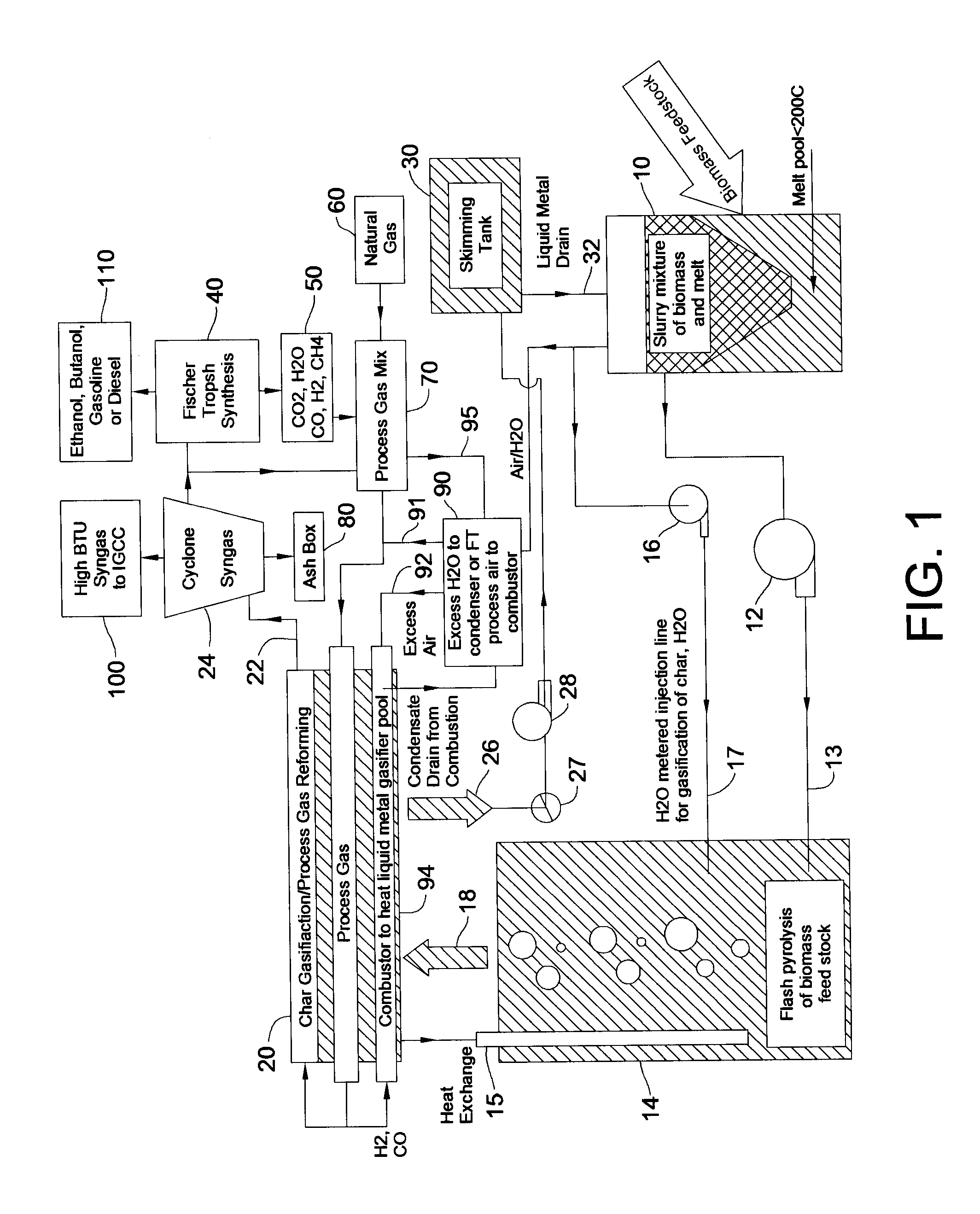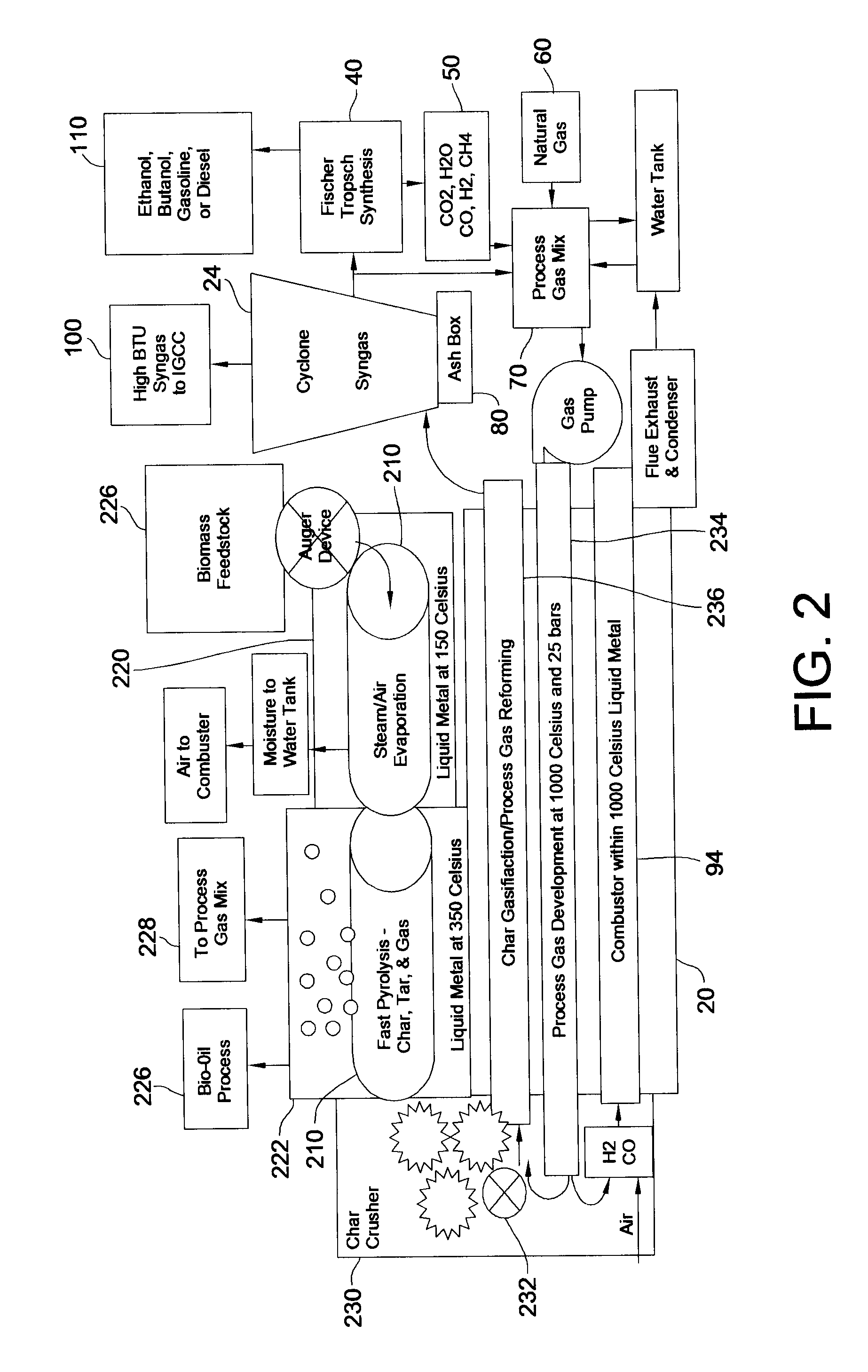[0030]A particular
advantage of the present invention is that it can convert mixed biomass feedstocks into
alkane fuels at high efficiency and without the need for an external
water source. In the case of “generic” wood as an exemplary biomass reactant, the full conversion of wood to
syngas requires an
enthalpy increase of 603 kJ / mol. (The overall reaction is C6H9O4+2H2O→6CO+6.5H2. The
combustion energy of the resulting
syngas, however, is 3,250 kJ / mol. Thus, backward integrating only 19% of the resulting syngas to heat the various
molten metal baths is all that is required to make the reactor self-sufficient. The remaining 81% of the product syngas can then be used in conventional fashion, e.g., for
direct combustion in a generator, for Fischer-Tropsch synthesis, etc.
[0031]Moreover, because the apparatus is heavily insulated (to limit
heat losses), once the apparatus is brought to operating temperatures, there is very little heat loss. Thus, roughly 1% of the syngas needs to be combusted to make up for molten liquid
heat losses once the apparatus is up and running. Thus the present invention enables a one-pass, 80% efficient water-gas shift / Fischer-Tropsch reactor (with 20% of the resulting syngas being combusted to heat the gasifier). The conversion of the syngas to iso-
octane involves an
enthalpy release of −760 kJ / mol. Water is fully recovered and recycled into the process. At 80% efficiency then, the Fischer-Tropsch exothermic heat of 608 kJ / mol is sufficient to dry the incoming biomass reactants. The
moisture is recycled for use in the gasification step.
Electricity can be generated from a fuel
cell operating at the same temperature as the gasification chamber. The
electricity so generated can then be used to drive the
auger, conveyers, and other ancillary equipment associated with the apparatus of the present invention. Thus, the device can be integrated into a self-powered mobile unit.
Biomass is the reactant. The resulting products are syngas (and liquid fuels made from the syngas),
electricity, N2 and CO2 exhaust gases, and
excess water.
[0032]Thus, the invention is directed to a method and corresponding apparatus for making syngas from biomass. A first version of the apparatus comprises a first molten liquid bath dimensioned and configured to maintain a molten liquid at a first temperature suitable for
drying a biomass reactant without degrading the biomass reactant. In this first bath, wet biomass is dried to yield dried biomass and process gas comprising water (and other gases). The first bath is operationally connected to, and dimensioned and configured to transfer molten liquid and dried biomass contained therein to a second molten liquid bath. The second bath is dimensioned and configured to maintain a molten liquid at a second temperature suitable for fast pyrolyzing the dried biomass to yield gas, tar, and char. The second bath is dimensioned and configured to transfer molten liquid, and the gas, tar, and char contained therein to a third molten liquid bath. This third bath is dimensioned and configured to maintain a molten liquid at a third temperature suitable for reforming the gas, tar, and char into synthesis gas. The third bath is dimensioned and configured to transfer molten liquid, tar, and char contained therein to a separator. The separator is dimensioned and configured to separate tar and char from the molten liquid to yield clean molten liquid. The separator is also operationally connected to the first molten liquid bath and is dimensioned and configured to transfer clean molten liquid back to the first molten liquid bath. Lastly, a conduit is operationally connects the first molten liquid bath to the third molten liquid bath. The conduit is dimensioned and configured to transfer process gas from the first molten liquid bath to the third molten liquid bath. Because water from the raw biomass is recycled into the third
molten bath, an
external source of water is not usually required (depending upon the initial
moisture content of the biomass).
[0033]A second version of the apparatus comprises a first molten liquid bath dimensioned and configured to maintain a molten liquid at a first temperature suitable for
drying a biomass reactant without degrading the biomass reactant, to yield process gas and dried biomass. A second molten liquid bath, dimensioned and configured to maintain a molten liquid at a second temperature, and suitable for fast pyrolyzing the dried biomass to yield gas, tar, and char, is also provided. A third molten liquid bath dimensioned and configured to maintain a molten liquid at a third temperature suitable for reforming gas, tar, and char into synthesis gas is also provided. A char
crusher is interposed between the second molten liquid bath and the third molten liquid bath. The char
crusher is dimensioned and configured to crush char into powdered char. A conveyer
assembly is provided to move reactants between the various chambers. The conveyor is dimensioned and configured to: (a) move the dried biomass from the first molten liquid bath to the second molten liquid bath; (b) to move char from the second molten method bath to the char
crusher; and (c) to move powdered char from the char crusher to the third molten liquid bath. As in the first version of the invention, a conduit is provided that operationally connects the first molten liquid bath to the third molten liquid bath. The conduit is dimensioned and configured to transfer process gas from the first molten liquid bath to the third molten liquid bath.
[0034]The inventive method is a method to convert a biomass reactant into synthesis gas. The method comprises heating biomass in a first molten liquid bath at a first temperature, wherein the first temperature is at least about 100° C., but less than the
decomposition temperature of the biomass, wherein process gas comprising water and small amounts of residual air and volatile organic compounds (VOCs) is evaporated from the biomass, thereby yielding dried biomass. The process gas evaporated from the biomass is captured. The dried biomass is heated in a second molten liquid bath at a second temperature, wherein the second temperature is sufficiently high to cause flash
pyrolysis of the dried biomass, thereby yielding product gases, tar, and char. Process gas can be added at this point to enhance char gasification immediately after the
pyrolysis event. The product gases, tar, and char are then reacted further with the process gas within third molten liquid bath at a third temperature which is equal to or greater than the second temperature within the second molten liquid bath, thereby yielding synthesis gas. A portion of the resulting synthesis gas is combusted to heat the first, second, and third molten liquid baths (unless external
natural gas or
hydrogen gas is available to be combusted instead).
[0035]The portion of the synthesis gas used to heat the device itself can be combusted to heat the third molten liquid bath only. Heat from the third molten liquid bath is then integrated to heat the second and first molten liquid baths (whose temperatures are lower than the third bath). The biomass reactants can be directly immersed into the various liquid baths, or heated indirectly by placing the biomass reactants within a suitable porous container that allows gas to escape the container but prevents molten liquid from entering the container.
 Login to View More
Login to View More 


